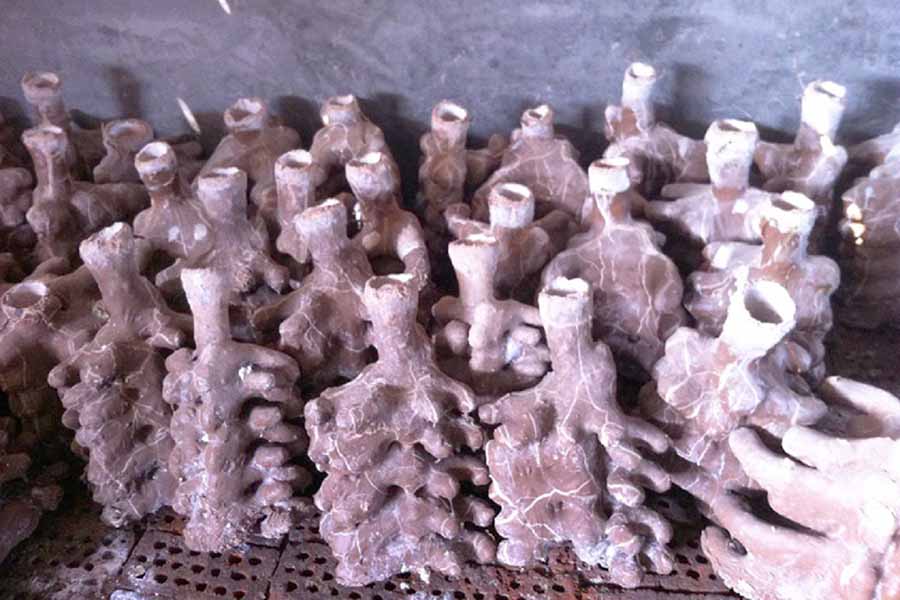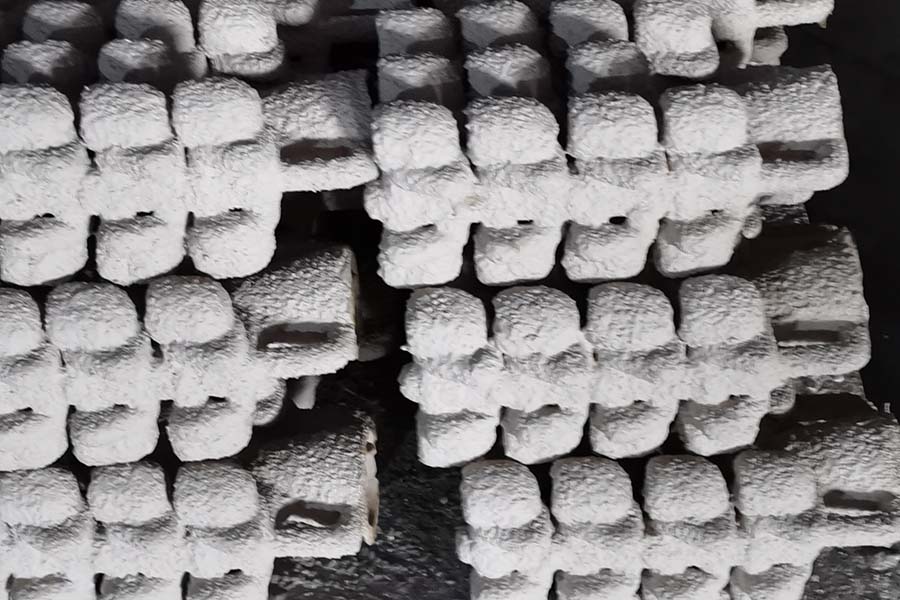Foundry coatings can be thought of as paints especially developed for the metal casting industry. The difference between conventional paints and a foundry coating is that the foundry coating is designed to withstand the high temperatures of molten metal and to act as a barrier between molten metal and a core or mold surface. Foundry coatings are also referred to as refractory coatings, protective coatings, washes, and blackings, even when the coating is not black.
All foundry coatings are suspensions of a high temperature mineral or refractory in a liquid carrier. After being applied to a core or mold surface the liquid is removed by evaporation and a layer of refractory is left on the sand surface. This layer or barrier can prevent or minimize the penetration of molten metal into the sand, can reduce or prevent "burn-on" and erosion of the sand and generally improves the quality of a casting surface.
The benefits of a foundry coating are only achieved if the coating is the proper one for the job and if the coating is correctly prepared, applied, and dried. Improperly selected, prepared or applied coatings can result in poor casting finish and / or applied coating defects such as scabs, blows, gas holes, inclusions, etc.
Benefits of Using a Refractory Coating:
• Reduce or eliminate metal penetration
• Reduce or prevent “burn-on”
• Prevent erosion of sand by molten metal
• Smoother surface finish
• Improve overall casting quality
• Reduced scrap
• Lower cleaning costs
The decision to use a foundry coating should be based on economics. To justify using a foundry coating, a reduction in cleaning and repair costs and/or reduction in costs due to scrapped casting must occur. These cost savings should more than offset the cost of the coating and the cost of applying and drying it.
Components of a Foundry Coating:
• Refractory Mineral
• Carrier / Reducer
• Binder
• Suspending Agent
• Special Additives - Defoamers, Wetting Agents, Biocides, etc.
Refractory Mineral
The refractory is the most important component of the coating. The coating, after being deposited on the sand and dried, is typically 90 -95% refractory and only 5 - 10% binder, suspending agent, etc. The refractory determines the resistance of the coating to molten metal, the effect of the coating on casting properties and to a great extent, the application properties of the coating. Refractories are often blended to improve cost performance and/or casting surface finish.
Carrier / Reducer
The carrier or reducer is the liquid phase of the coating as manufactured and is also the liquid used to dilute the coating. The terms ‘carrier’, ‘reducer’, ‘solvent’, and ‘vehicle’ mean the same and are often used interchangeably. The only function of the carrier is to carry or transfer the refractory particles to the core and mold surface. Upon evaporation of the carrier, a layer of refractory solids remains behind, which will act as a barrier between the sand and molten metal. Carriers or reducers are often blended to modify drying and ‘light-off’ characteristics, to improve the solubility of the coating binder, and to control how deeply the coating penetrates into the sand.
Binder
The function of the binder is to bond the refractory particles together and to the sand. A wide variety of binders are used including acrylics, starches, and wood derived resins. A careful balance between film hardness, adhesion to sand, flexibility and loss upon ignition must be made. The properly chosen binder results in good dry film hardness, allows the dry coating to withstand normal handling, has enough flexibility to accommodate sand expansion, and does not cause gas porosity in the casting. Binders for water -based coatings that are torch dried also require high resistance to blistering.
Suspending Agent
The primary function of suspending agents is to keep the refractory particles in suspension and to prevent hard settling during storage, shipment, and use of the coating at its working viscosity. Commonly used suspending agents are clays, polymers, and gums. Suspending agents, in addition to keeping the refractory particles in suspension, affect how easily the coating can be remixed and how the coating applies when dipped, brushed, swabbed or sprayed.Special Additives
May include; defoamers, wetting agents, biocides, dispersants, and leveling agents. These additives are used to modify and improve application characteristics, shelf life, and contribute to overall casting performance.

Refractory Considerations:
• Types of Metal Poured
• Pouring Temperatures (min. and max.)
• Cross Sectional Areas of Casting
• Resistance of Refractory to Metal Penetration
• "Peel" Characteristics
• Thermal Conductivity of Refractory
• Thermal Expansion and Contraction
• Application Characteristics
• Cost
• Toxicity of Refractory
• Uniformity of Refractory from Shipment to Shipment
• Permeability
Factors to Consider in Choosing a Carrier:
• Compatibility of carrier with sand binder and / or refractory
• Method of drying and available equipment
• Required drying speed
• Flammability and “burning” characteristic
• Toxicity
• Odor
• Method of application (dip, spray, brush, swab, or flow-coat)
• Cost of carrier
• Cost of labor
• Available floor space & utilization of floor space
Commonly Used Carriers
• Water (recommended carriers)
• Isopropyl Alcohol (recommended carriers)
• Methanol
• Naphtha
Water-Based Coatings
ADVANTAGES
• Lowest Cost to Purchase
• Non-Toxic
• Non-Flammable
DISADVANTAGES
• Heat required to dry coating
• Complete drying of deep pockets in a reasonable time can be difficult
• Greater tendency than "light-off" or air dry coating for tears or runs
• Higher labor costs
• Reduces tensile strength of urethane no-bakes, cold box, and silicate sands
• Increased potential for core breakage
• Possible degradation of cores during storage
• Loss of floor space because of ovens and extra conveyors
• High initial investment required for ovens
• Operating and maintenance costs required for oven
• Coating subject to freezing
Isopropyl Alcohol
Recommended if fast drying is required and if flammability is not a problem. All containers containing either isopropyl alcohol or an alcohol based coating must be kept covered when not in use, properly grounded, and kept away from heat, sparks, and an open flame.
Recommend the usage of only 99% isopropyl alcohol. The use of 91% alcohol can cause some coatings to thicken, to lose suspension, or not to “light-off” or burn completely dry. Reducer compatibility should be checked before using.
Light-Off Coatings
ADVANTAGES
• Fast drying
• Good wetting properties
• Good penetration into sand
• Retards moisture absorption by stored cores
• Heat generated by flame can accelerate cure of no-bake sands
• Reduced handling of cores
• Lower labor costs
• Increased productivity
• Ovens are not required for drying
• Better utilization of floor space
DISADVANTAGES
• Fire hazard
• Potential toxicity hazard
• Possible blistering of coating
• Possible degradation of cores and molds by hot burning solvents and by excessive solvent penetration

Quick Links:
Sand Casting | Investment Casting | CNC Machining | Lost Foam Casting | Vacuum Casting | Get a Quote
 русский
русский



